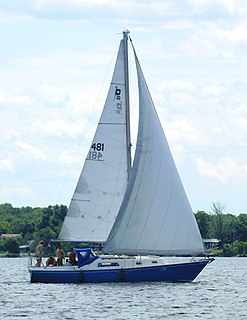Related Research Articles

The Flying Dutchman is a Dutch planing sailing dinghy that was designed by Uus Van Essen and Conrad Gülcher as a high performance, one design racer and first built in 1951.

The Laser 2, or Laser II, is a sailboat that was designed by New Zealander Frank Bethwaite and Canadian Ian Bruce as a one-design racer and first built in 1978.

The Snipe is an American sailing dinghy that was designed by William F. Crosby as a one design racer and first built in 1931.

The International FJ is a Dutch sailboat that was designed by Uus Van Essen and Conrad Gülcher as a trainer and one design racer, first built in 1956.
The Ranger 32 is an American sailboat, that was designed by Gary Mull as an International Offshore Rule Three-Quarter Ton class racer and first built in 1973. The design is out of production.
The W. D. Schock Corporation is an American boat builder originally based in Newport Beach, California, later in Corona, California and currently located in Santa Ana, California. The company was founded by William "Bill" D. Schock in 1958 and specializes in the design and manufacture of fiberglass sailboats.
The Harmony 22 is an American trailerable sailboat that was designed by Chris Bjerregaard as a Midget Ocean Racing Club (MORC) racer and first built in 1977.
The S2 9.1 is an American sailboat that was designed by Graham & Schlageter as a Midget Ocean Racing Club (MORC) racer and first built in 1983. The boat was built in a variety of models. The designation indicates the approximate length overall in meters.

The Wavelength 24 is an American trailerable sailboat that was designed by Paul Lindenberg as a Midget Ocean Racing Club (MORC) racer and first built in 1982.
The Seafarer 37 is an American trailerable sailboat that was designed by McCurdy & Rhodes as a cruiser and first built in 1980.
Seidelmann Yachts was an American boat builder based in Berlin, New Jersey. The company specialized in the design and manufacture of fiberglass sailboats.
The Seidelmann 24, sometimes called the Seidelmann 24-1, is an American trailerable sailboat that was designed by Bob Seidelmann, Bruce Kirby and W. Ross, as a racer-cruiser and first built in 1981.
The MacGregor 21 is an American trailerable sailboat that was designed by Roger MacGregor as a racer-cruiser and first built in 1980.
The Laguna 24S is an American trailerable sailboat that was designed by W. Shad Turner as a cruiser and first built in 1980.
Hughes Boat Works was a Canadian boat builder based in Centralia, Ontario. The company specialized in the design and manufacture of fibreglass sailboats.

The Pearson 30 is an American sailboat that was designed by William Shaw as a cruiser and first built in 1971.

The Farr 727 is a trailerable sailboat that was designed by New Zealander Bruce Farr as an International Offshore Rule Quarter Ton class racer and first built in 1976. The boat was also built in Canada as the North Star 727.
The Tartan 27 is an American trailerable sailboat that was designed by Sparkman & Stephens as a cruiser-racer and first built in 1961. It is Sparkman & Stephens' design #1617.

The Wavelength 30 is an American sailboat that was designed by Paul Lindenberg as a racer-cruiser and first built in 1980.
The Wavelength 35 is an American sailboat that was designed by Paul Lindenberg as a racer-cruiser and first built in 1980.
References
- 1 2 3 4 McArthur, Bruce (2022). "Lindenberg 30". sailboatdata.com. Archived from the original on 22 August 2022. Retrieved 23 August 2022.
- 1 2 3 4 5 Sea Time Tech, LLC (2022). "Lindenberg 30". sailboat.guide. Archived from the original on 22 August 2022. Retrieved 23 August 2022.
- ↑ McArthur, Bruce (2022). "Paul Lindenberg". sailboatdata.com. Archived from the original on 22 December 2021. Retrieved 23 August 2022.
- ↑ Sea Time Tech, LLC (2022). "Paul Lindenberg". sailboat.guide. Archived from the original on 22 August 2022. Retrieved 23 August 2022.
- ↑ McArthur, Bruce (2022). "Wavelength 30 sailboat". sailboatdata.com. Archived from the original on 22 August 2022. Retrieved 22 August 2022.
- ↑ Sea Time Tech, LLC (2022). "Wavelength 30". sailboat.guide. Archived from the original on 22 August 2022. Retrieved 22 August 2022.
- ↑ McArthur, Bruce (2022). "Lindenberg Yachts". sailboatdata.com. Archived from the original on 23 August 2022. Retrieved 23 August 2022.
- ↑ Sea Time Tech, LLC (2022). "Lindenberg Yachts". sailboat.guide. Archived from the original on 23 August 2022. Retrieved 23 August 2022.
- ↑ "The Month in Yachting". Yachting . January 1980. Retrieved 23 August 2022.